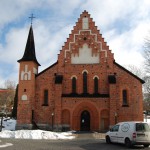Sigtuna (Sweden)
In the month of March of this year as we were travelling throughout Sweden we just could not but pay attention to the first capital of Sweden — the city of Sigtuna. Sigtuna is a city in central Sweden, in the capital agglomeration of Stockholm. It is located on the shore of the Mälaren Lake connected to the Baltic Sea by a strait. Its population is around 40 thousand people.
The city was founded, according to different sources, either by Eric VI the Victorious or Olaf Shötkonung around 1000. Archeological researches show that constructions on the site of the city, however, existed a long time before that.
In the past, Sigtuna was one of the most important cities of Sweden, a political and religious center during the epoch of early Christianization, a big trading center of the country in XI—beginning of XII century. In 990s, here the first silver coins in Sweden were minted; they had on them an image of Olaf Shötkonung.
In August of 1187, the city was captured and destroyed. In one of the ancient manuscripts, Karelians are mentioned as the nation who attacked Sigtuna; in others it is Aestii. The adversaries in the chronicles are called «pagani» — pagans. There is a legend that the so-called Sigtuna gates in the Sofia Cathedral of Veliky Novgorod were brought there and set up as a military trophy.
In medieval centuries seven stone churches (churche) were erected in the city. Today, ruins of the three churches: St. Per, St. Lars, St Olof can be found in the city.
Dominican Saint Mary’s Church built of brick, which dates back to the middle of XIII century, is well preserved.
In Sigtuna there is a boarding school, in which among others king of Sweden Carl XVI Gustaf and prime minister Olof Palme studied.
In Sigtuna there are more runic stones (more than 150) than in any other place in the world. In the city itself there are ten runic monuments. The rest of the 150 runic stones are in the vicinity of the city. The stones date back to around XI century AD.
http://ru.wikipedia.org


